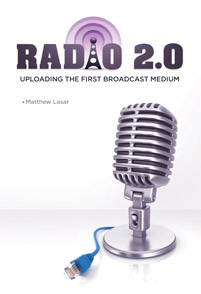 My third book about radio is scheduled to be released on March 31 by its publisher, ABC-CLIO. It is titled Radio 2.0: uploading the first broadcast medium. The writer Susie Bright has already noticed its release via her Twitter account. The press has a very nice page for the small tome on its website. I thought I’d write up something for it here.
My third book about radio is scheduled to be released on March 31 by its publisher, ABC-CLIO. It is titled Radio 2.0: uploading the first broadcast medium. The writer Susie Bright has already noticed its release via her Twitter account. The press has a very nice page for the small tome on its website. I thought I’d write up something for it here.
The whole “2.0” trope is, admittedly, a bit of a cliche. But I use it in this instance in a dialectical sense. First I make the case for the historical existence of “Radio 1.0” – a stretch of around sixty years in which AM/FM broadcasters streamed to something called “audiences.” These I define as large groups of people who took in radio content immediately and simultaneously, often conscious of themselves as such. The book contends that this was good for the United States. Radio 1.0 contributed to the forging of a national consciousness sufficiently coherent and self-confident to permit the greater integration of women, minorities, and working class people into the social structure. It is no coincidence, I argue, that broadcast radio’s greatest years coincide with 1920s feminism, the New Deal, and the civil rights struggles of the 1940s, fifties, and sixties.
Beginning in the 1970s, however, our government made a series of “constitutive choices,” to borrow Paul Starr’s noted phrase, that undermined not just some of the hallowed underpinnings of twentieth century broadcasting, such as localism, but the very concept of the audience itself. The audience now played a back seat to something called “competition,” which somehow would be furthered by breaking down media ownership barriers. This ironically led to the rise of the Clear Channel empire, whose principals very purposefully turned away from an audience based business model. Now conglomeration, informercialism, and maniacal cost cutting ruled the day.
As this new approach prevailed, a sort of vast audience technological diaspora followed. Its earliest manifestation predated the Internet by two decades. The SONY Walkman led the way towards the “personalization” of listening, followed by Discmen and CD-ROM men and subsequent digital men who created audio “pods” and then colonized the gadget once discouraged by government regulators from getting too far into radio, the telephone, now proudly wireless and digitized. Listening was now “asynchronous,” declared Internet radio pioneer Carl Malamud, for “asynchronous times.”
For those of you worried that from this point of departure my book descends into a sort of liberal Luddite narrative of decline, fear not. I spend quite a few pages celebratorily exploring all the audio techno-marvels of our age, many of which I have immensely enjoyed, among them Live 365, the grand legion of SHOUTcasters, Pandora, Spotify (and things within Spotify), Last.fm, podcasting, and the Turntable.fm phenomenon, which I dub a form of “deejay texting.”
I also note that one of the earliest visionaries of radio anticipated all this. Back in the 1920s, informed by German experimentalism and the wireless Morse code phenomenon, Bertold Brecht wondered out loud about the possibilities of a radio broadcasting system that allowed the listener to “speak as well as hear” and to bring this person into a “relationship instead of isolating him.” How, I ask, can Radio 2.0, which fulfills these tasks so well, merge in our time with the socially cohesive virtues of Radio 1.0? In answering this question, my lamplight shines on various examples: among them pioneering online community based broadcasters in the United States and the United Kingdom’s World Have Your Say service.
How can we synthesize the best of Radio 2.0 with its historical predecessor? Let’s stop speculating about the future of radio, I suggest, and start proactively thinking about what we want radio to be – even considering what the word “radio” means in the most virtuous social sense. That is what my book aspires to say.
I should add that I could not have written this book without continuously reading the words of my excellent teachers, Paul Riismandel and Jennifer Waits, here on the pages of Radio Survivor. They educated me about so many more radio possibilities than I knew of back when I spent my days narrating Pacifica radio’s accomplishments and troubles. I also have benefitted greatly from recent scholarship on radio produced by John Nathan Anderson, Dolores Inés Casillas, and Daniel Gilfillan, among others.
Anyway, Radio 2.0 will be out soon enough. It’s in the pre-order stage at Amazon and all the usual other places. I’m glad it’s done and hope it is of some use to somebody. That, of course, will be decided by others, perhaps even you.


